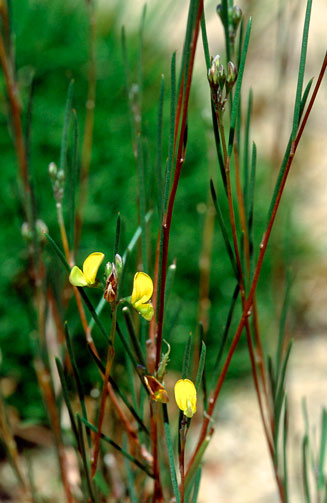|
Aspalathus linearis (Rooibos tea) Life
> eukaryotes >
Archaeoplastida >
Chloroplastida
>
Charophyta > Streptophytina > Plantae (land plants)
> Tracheophyta (vascular plants) > Euphyllophyta > Lignophyta (woody plants)
> Spermatophyta (seed plants) > Angiospermae (flowering
plants) > Eudicotyledons > Core Eudicots > Rosids >
Eurosid I > Fabales > Family: Fabaceae > Subfamily: Papilionoideae
> Genus: Aspalathus
 |
|
Rooibos, Aspalathus linearis, plantation
with Rain daisies, Dimorphotheca pluvialis, in Sandveld near
Clanwilliam, Western Cape, South Africa. [photo
Colin Paterson-Jones ©] |
 |
 |
|
Wild plant of Rooibos, Aspalathus linearis,
flowering in spring in habitat on Sir Lowry's Pass, Western Cape South
Africa. [photo
Colin Paterson-Jones ©] |
Aspalathus linearis, Gifberge, Western
Cape, South Africa. [photo
H.G.
Robertson, Iziko ©] |
 |
|
Harvested Rooibos, the stems and leaves of
Aspalathus linearis, after milling, being turned on an open air
drying floor after milling on a farm on the Matsikamma, Western Cape,
South Africa. [photo
Colin Paterson-Jones ©] |
Native to the Western Cape, South Africa. Rooibos tea is
derived from the leaves and twigs of this plant and was a drink developed by the
local Khoi people. In 1904, a Russian immigrant and tea merchant by the name of
Benjamin Ginsberg started buying the tea from the Khoi and marketing it
commercially. Rooibos tea has now become a popular tea in many parts of the
world because it contains no stimulants and in particular, no caffeine. To
produce the tea, the leaves and twigs are harvested, crushed by hammering to
promote a fermentation process, and dried. Further processing to package it in
tea bags is the norm these days.
Publications
- Van der Bank, M., Van Wyk, B.-E. & Van der Bank,
F.H. 1995. Biochemical genetic variation in four wild
populations of Aspalathus linearis (Rooibos tea).
Biochemical Systematics and Ecology 23: 251–256.
-
Van Wyk, B.-E. 2005. Food Plants of the World -
Identification, Culinary Uses and Nutritional Value. Briza, Pretoria.
|
